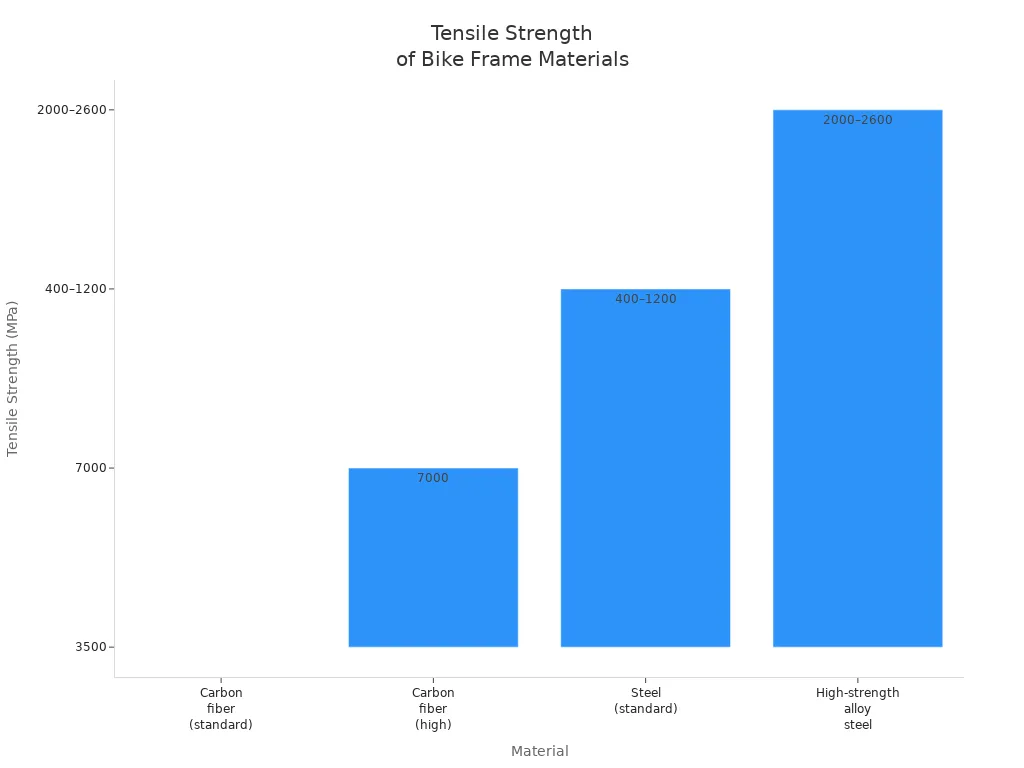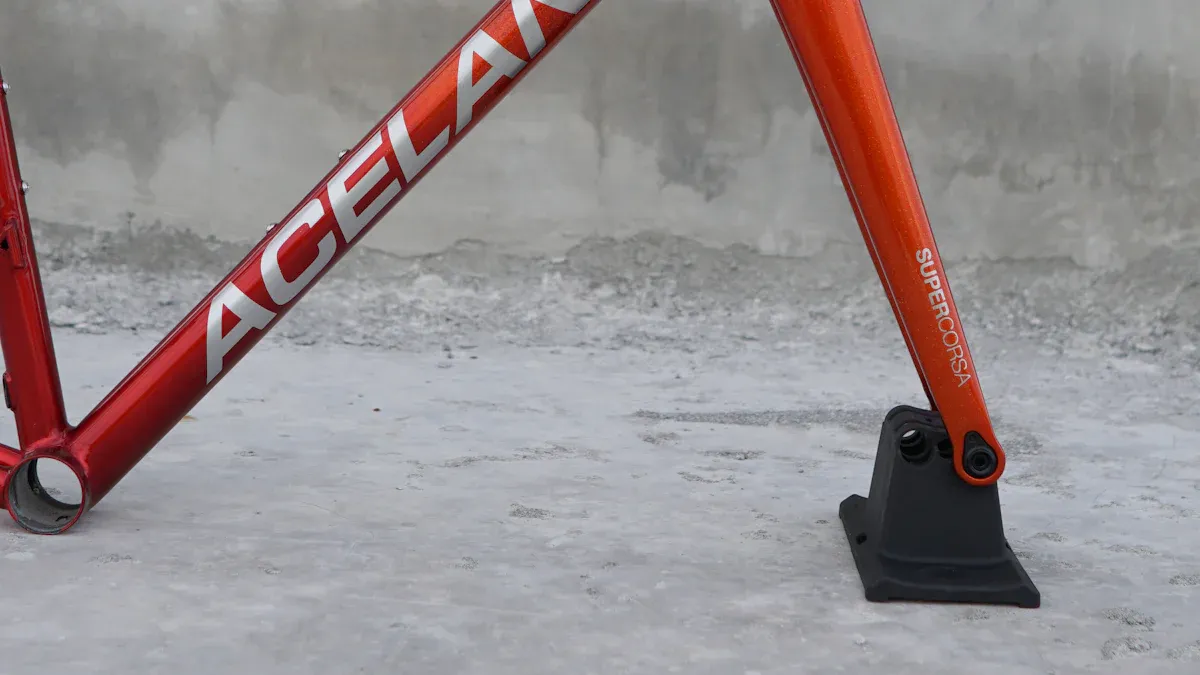
Choosing the right bike frame material is very important for your cycling experience in 2025. It can change how you ride and perform on the road or trail. A carbon aluminum bike frame offers unique advantages. With carbon, you usually get a lighter and stiffer ride, which can help you go faster. On the other hand, aluminum frames are often cheaper and last longer. Knowing these differences helps you make a smart choice that fits your riding style and preferences.
Key Takeaways
Carbon bike frames are lighter and stronger. This makes them great for racing and climbing. They help you go faster with less work.
Aluminum frames cost less and last longer. This makes them a good choice for daily riding and commuting.
Carbon frames soak up road bumps better. This gives you a smoother ride. Aluminum frames can feel bumpier on rough roads.
Think about your budget: carbon frames usually cost more. But they give serious cyclists better performance over time.
Taking care of carbon frames is very important. This helps them last longer. Aluminum frames are easier to maintain and resist damage better.
Carbon vs Aluminum: Material Properties

Carbon Frame Features
When you think about carbon frames, some important features stand out. First, carbon fiber is very strong but also light. This material has a high strength-to-weight ratio. It makes your bike easier to handle and faster on hills. Here are some key traits of carbon frames:
High Tensile Strength: Carbon fiber can reach tensile strengths up to 7,000 MPa. This is much higher than steel. Your carbon frame can take more stress without bending or breaking.
Stiffness: Carbon fiber is very stiff. This helps your bike perform better and respond quickly. This stiffness allows for efficient power transfer when pedaling. It helps you go faster with less effort.
Fatigue Resistance: Carbon frames resist fatigue well. They can handle long rides without losing strength. This durability is important for serious cyclists who use their bikes a lot.
Customizability: You can shape carbon fiber into different designs. This lets manufacturers create frames that improve aerodynamics and comfort.

Aluminum Frame Features
Aluminum frames, especially those made from alloys like 6061 and 7005, have their own benefits. Here’s what you should know about aluminum frames:
Lightweight: Aluminum is much lighter than steel. This helps with climbing and speeding up. It is a popular choice for cyclists who want a mix of weight and strength.
Strength-to-Weight Ratio: The 6061 aluminum alloy is strong enough for tough rides. It stays light for easy handling. This means you can enjoy a responsive ride without extra weight.
Corrosion Resistance: Aluminum forms a protective oxide layer. This stops rust from forming. This feature makes aluminum frames easy to maintain, especially in wet weather.
Stiffness: Aluminum frames have a high stiffness-to-weight ratio. This allows for larger tube sizes without extra weight. This gives you a responsive ride that can handle different terrains.
Weight Comparison: Carbon vs Aluminum

Weight of Carbon Frames
Carbon frames are very light. They weigh much less than aluminum frames. This can really change how you ride. Here are some important facts about carbon frame weight:
Lightweight Advantage: Carbon fiber frames usually weigh 1.5 to 2 pounds less than aluminum ones. This lighter weight can make your cycling experience better.
Acceleration Boost: Because carbon fiber is light, you can speed up faster. You will use less energy to start moving, especially during quick sprints.
Climbing Efficiency: If you enjoy climbing hills, a carbon frame is great. The lighter weight helps you climb better. Steep hills feel easier. Many riders say carbon frames make climbing feel “effortless” compared to heavier aluminum frames.
Tip: If you race bikes, think about how a carbon frame can help you go faster. The stiffer design helps you use your energy better. This means more power goes directly to the wheels.
Weight of Aluminum Frames
Aluminum frames are heavier than carbon, but they still have good points. Here’s what to know about their weight:
Slightly Heavier: Aluminum frames are usually 1.5 to 2 pounds heavier than carbon ones. This extra weight can be felt, especially when climbing or speeding up.
Power Requirement: You may need to use 7-10% more power on aluminum frames to go as fast as on carbon frames. This can affect your performance, especially in races.
Handling: Even though aluminum frames are heavier, they handle well. The stiffness lets them have bigger tube sizes without adding too much weight. This gives you a responsive ride.
Ride Comfort: Carbon vs Aluminum
Comfort of Carbon Frames
Carbon frames are great for ride comfort. They naturally reduce vibrations, making them popular with cyclists who want a smooth ride. Studies show that carbon fiber absorbs bumps better than aluminum. This means you feel fewer jolts from the road. Many cyclists say their carbon bikes are more comfortable, especially on long trips. One rider even said switching to a carbon bike made a big difference in comfort compared to their steel bike.
The important part is the lower Root Mean Square (R.M.S.) acceleration values in carbon frames. This shows less vibration, which makes riding more enjoyable. If you like riding on bumpy roads, a carbon frame could be the best choice for you.
Comfort of Aluminum Frames
Aluminum frames have some comfort features, but they aren’t as good as carbon. The comfort level in aluminum frames depends on things like vertical stiffness and frame shape. For example, a less stiff frame can give a more comfortable ride. Many cyclists find that changing the seat tube’s thickness can improve comfort.
However, aluminum frames send more vibrations from the road to you. This can make the ride feel rougher, especially on bumpy paths. In tests, aluminum frames showed less shock absorption than carbon frames. While they are still light and responsive, you might feel more bumps while riding.
Durability and Maintenance: Aluminum vs Carbon
When you think about how long bike frames last, both carbon and aluminum have good and bad points. Knowing these can help you pick the right one for your riding style.
Durability of Carbon Frames
Carbon frames are strong but can break more easily than aluminum. They might crack if hit hard, which can be dangerous. However, if you take care of them, a carbon frame can last about 10 to 12 years with normal use. Here are some tips to keep your carbon frame in great condition:
Inspect Regularly: Check for cracks, chips, or wear after each ride.
Clean Gently: Use mild soap to avoid hurting the carbon fiber.
Protect Against Impacts: Think about using frame protectors to reduce damage risks.
If you take good care of your carbon frame, it could last a very long time. Regular maintenance is important to make it last longer.
Durability of Aluminum Frames
Aluminum frames are usually tougher against dents and scratches. They can handle rough conditions better than carbon frames. If you fall, an aluminum frame might get a dent but often stays rideable. Here’s what you should know about aluminum durability:
Material | ||
|---|---|---|
Aluminum | More likely to dent | Sometimes rideable after minor damage |
Carbon | Tends to crack | Professional repairs can restore strength |
While you can fix aluminum frames, big damage often means you should replace them. Repairing aluminum can be expensive and may not always be easy.
Cost Analysis: Aluminum Bike Frames
Price of Carbon Frames
When you check out carbon bike frames, you will see many prices. In 2025, the cost can change a lot based on the brand and model. Here’s a quick look at some popular choices:
Brand and Model | Price | Main Selling Point |
|---|---|---|
Trek Butterfly Madone | $500,000 | Artistic design by Damien Hirst with real butterfly wings |
Specialized S-Works Epic 8 | $12,000 | Lightweight carbon with custom shock system |
Trek Madone SLR 9 AXS Gen 8 | $15,999 | 900 Series OCLV Carbon, aerodynamic shape |
Cannondale SuperSix EVO Lab71 Team | $14,000 | Series 0 Carbon, smart racing shape |
Specialized S-Works Tarmac SL8 | $14,000 | Advanced aerodynamics, weighs only 685 grams |
KAWS x Trek Madone | $160,000 | Unique design by artist KAWS |
BMC Lamborghini Impec | $32,000 | Combines car design with bike performance |
Audi Sport Racing Bike | $18,620 | Light frame, top parts for racing |
Pinarello Bolide F | $38,000 | Aerodynamic shape, high performance |
Colnago V4Rs | $17,000 | Top materials, built for speed |

As you can see, carbon frames can be expensive, especially for high-end models. But if you need to save money, entry-level carbon frames from good brands offer quality and performance without costing too much.
Price of Aluminum Frames
Aluminum frames usually cost less than carbon ones. You can find good aluminum bike frames for $500 to $2,500. This makes them a popular choice for many riders. Here are some budget points to think about:
Many cyclists worry about the cost of high-end carbon bikes. They often choose aluminum frames because they are cheaper.
More people are realizing that entry-level carbon frames from trusted brands offer good quality and performance. This makes them a good choice for those on a budget.
While carbon frames may cost more at first, their long-term value and ride quality can make them worth it. This is especially true for those who love cycling.
Choosing between carbon and aluminum bike frames often depends on your budget and riding goals. If you want a high-performance bike and can pay for it, carbon might be best. But if you want something cheaper that still works well, aluminum frames are a great choice.
Final Recommendations: Frame Comparison
When picking between carbon and aluminum bike frames, think about how you ride and what you want to achieve. Each material has good points that fit different types of cyclists.
Best Use Cases for Carbon Frames
Carbon frames are great for racing. If you like racing or long rides, you will love how light and quick they are. Here are some times when carbon frames work best:
Competitive Cycling: Their light design helps you go faster and be more agile. You will feel the difference when you sprint or climb.
Road Racing: Carbon frames help you cut through the air better, which improves your speed on the road.
Endurance Cycling: They are strong and absorb shocks well. This makes long rides easier, so you can ride longer without getting tired.
Cycling Discipline | |
|---|---|
Competitive Cycling | Lightweight and quick for speed and agility |
Road Racing | Helps you go faster with better aerodynamics |
Endurance Cycling | Strong and absorbs bumps for long rides |
Best Use Cases for Aluminum Frames
Aluminum frames are great for everyday riders and those who want to save money. They give a good mix of performance and cost. Here’s when you might pick an aluminum frame:
Commuting: If you ride to work or school, aluminum frames are tough and won’t rust. They work well in different weather.
Recreational Riding: For fun rides with friends or family, aluminum frames are comfy and won’t cost too much.
Mountain Biking: Aluminum frames are strong and can handle rough trails, making them perfect for off-road fun.
Pros | Cons |
|---|---|
Light and easy to ride | Can feel rough on bumpy paths |
Cheaper than other options | Might wear out faster with heavy use |
Good energy transfer | Shorter lifespan than steel or titanium |
Choosing between carbon and aluminum bike frames in 2025 depends on how you ride and what you like. Here are some important things to think about:
Riding Style: If you race or go long distances, carbon frames give you speed and comfort. For casual rides or getting to work, aluminum frames are strong and cheaper.
Comfort: Carbon frames are great at reducing bumps, making your ride smoother. Aluminum frames can feel bumpier on rough paths.
Budget: Carbon frames usually cost more, while aluminum ones are less expensive.
Maintenance: Carbon needs careful care, but aluminum is easier to look after.
As technology improves, think about eco-friendly choices too. Both materials have good and bad points, so consider what is most important to you when deciding.
FAQ
What are the main differences between aluminum vs carbon bike frames?
Aluminum frames usually cost less and last longer. Carbon bike frames are lighter and better at absorbing bumps. Your choice should depend on how much money you have and how you ride.
How long do carbon bike frames last compared to aluminum?
Carbon bike frames can last about 10 to 12 years if you take care of them. Aluminum frames might last longer, but they can get dents and wear out over time.
Are carbon bike frames worth the extra cost?
If you care about performance, speed, and comfort, carbon bike frames are a good buy. But if you need to save money, aluminum frames still give you great quality.
Can I repair a damaged carbon frame?
You can fix a carbon frame, but it usually needs a professional. Aluminum frames are easier to repair, but if they get serious damage, you might need to replace them.
Which frame is better for mountain biking?
For mountain biking, aluminum frames are often better because they are tough and can handle rough trails. You can use carbon frames, but they might get damaged more easily.
See Also
The Benefits of Carbon Bike Frames for Cyclists in 2025
Understanding Carbon, Aluminum, and Steel Bike Frames for Shoppers
Evaluating the Durability of Aluminum Bike Frames: Pros and Cons
Selecting the Perfect Aluminum Road Bike Frame for Your Style
